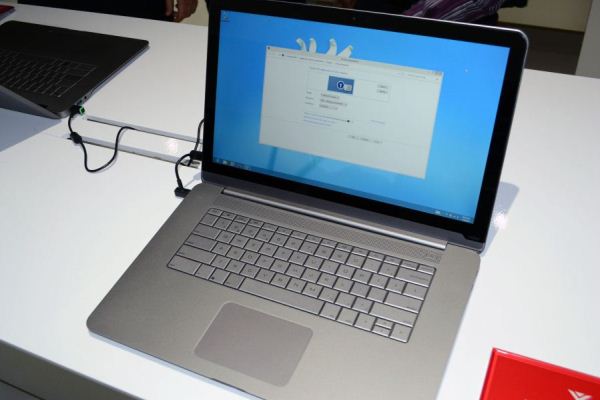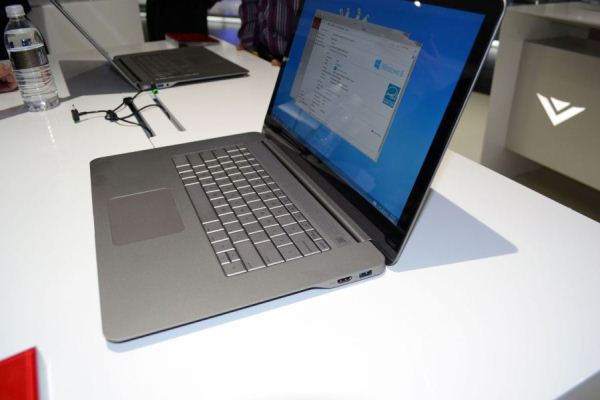Vizio's New Touch Notebook and AIO PCs at CES
by Vivek Gowri on January 14, 2013 3:15 PM EST- Posted in
- Trade Shows
- IPS
- all-in-one
- Vizio
- CES 2013
- Ultrabook
- Touc
Vizio used CES as the platform to debut the third revision to its PC lineup, which currently consists mostly of ultrabooks and all-in-ones. The first revision was the initial launch last summer, while the second revision brought touchpad updates (replacing the godawful Sentelic pads with better Synaptics units) and Windows 8. This third revision brings touchscreens and quad-core CPUs across the board to all Vizio systems, regardless of notebook or all-in-one.
Vizio’s notebook lineup is presently structured with a Thin+Light and a Notebook; the former is available in two form factors (14” 900p and 15.6” 1080p) with Intel’s ULV processors, solid state storage, and integrated graphics, while the Notebook is 15.6” 1080p with quad-core IVB processors, Nvidia’s GT 640M LE graphics, and a 1TB hard drive paired with a 32GB caching drive. Across the board, we see IPS display panels, fully aluminum chassis, and uniform industrial design.
The new Thin+Light Touch again come in 14” and 15” models, with either AMD A10 or Ivy Bridge i7 quads exclusively, with AMD dedicated graphics available with the AMD model. The dual-core and ULV parts are gone, and with nary a mention of the CN15 Notebook, it would appear that it has been killed off because of too much overlap with the Thin+Light Touch. Both quad-core CPUs and dedicated GPUs are available in the latter, so you’re not losing much, though that means there is no longer an Intel quad + dGPU config on offer.
As can probably be surmised from the name, the Thin+Light Touch is available exclusively with a capacitive multitouch display. This adds a bit of thickness and weight to the chassis, but the 15.6” model is still 4 pounds (from 3.89lbs before) so it’s not a huge amount. Other improvements include a much more structurally sound palmrest and interior, which results in significantly less flex in both the body as well as the keyboard. This is likely the most significant of the chassis-level upgrades, and fixes the last major flaw from the second revision notebooks. Battery capacity has been “nearly doubled” which indicates capacity should be close to 100Wh (the previous Thin+Light was 57.5Wh) with the hope of substantially improving battery life.
It seems like a pretty targeted generational update, with all of the pain points from the first two notebooks fixed. I think I’d still like to see some improvements in terms of ports on offer (2xUSB and no SD slot just isn’t enough), but the gorgeous IPS display and nice industrial design make up for any remaining flaws. Price points are expected to be similar to the previous Thin+Light, and availability is expected to be in the early spring timeframe.
Vizio also had its All-in-One Touch series desktops at their suite in the Wynn, though these are not new products. Vizio updated the AIO series with touchscreen displays and Synaptics touchpads at the Windows 8 launch, and simply brought those to Las Vegas to complement their new notebook, tablet, and HDTV products on the show floor.
























12 Comments
View All Comments
tipoo - Monday, January 14, 2013 - link
The design of these things is great, and the premise of a company new to building PCs doing things right by not installing bloatware was nice. However they went with some pretty bad trackpads and keyboards, and the battery life was also pretty low (although that could be because of the nice IPS screen). If these things have improved, everything else about these is appealing.VivekGowri - Monday, January 14, 2013 - link
They fixed the touchpad on the Windows 8 versions (Synaptics instead of Sentelic). Keyboard is still terrible though, and battery life is meh. The new one is way, way better in terms of keyboard, and theoretically battery as well.tipoo - Tuesday, January 15, 2013 - link
Cool, didn't know that, thanks. Synaptics trackpads with the Windows 8 driver are actually very good, not Macbook good but maybe 80% as good. No complaints on my 3 year old Dell with Synaptics and the new multitouch driver.SilentSin - Monday, January 14, 2013 - link
Were the specs you outlined applicable to the 14"? Namely the 1080p screen and 100Wh battery. I'm guessing not since the 14" card only states "HD+" (900p?) where the 15.6 says full hd. If they can get a 1080p 14" with an A10 for ~$800 I'd be all over it.VivekGowri - Monday, January 14, 2013 - link
Yeah, 15" is 1080p, 14" is 900p. From the article: "... two form factors (14” 900p and 15.6” 1080p)..."I wish the 14" was 1080p, man that'd be awesome.
kyuu - Monday, January 14, 2013 - link
I actually appreciate the 1600x900 in the 14" form factor. Should allow for lower pricing, and the pixel density is more than adequate. The screen being good quality is more important than simply pushing extra pixels, IMO, and it seems like Vizio does use good panels.If the keyboard issues are resolved, then I'm actually very tempted to go with the 14" model with an A10 when these are released.
SilentSin - Tuesday, January 15, 2013 - link
Totally missed that sentence my bad. That is a step up, the only other notebook to offer that with an AMD APU at 14" 900p has been HP's ProBook line IIRC which is quite bulky and expensive, although the components are top notch. 1080p can't be much more expensive to put in tho..5-6" phones are getting them now why can't 13-16" laptops?I do hope that 100Wh battery makes it to the 14" base model without having to pay for some sort of "MAXX" edition. Notebooks are starting to go the way of phones where they have these awesome CPUs that sip power, but instead of taking advantage of that they just shave off a mm and 100g of battery to try and retain the "lightest laptop evers omg!!@121" throne and keep battery life the same as last year's model instead of making it more usable (longer life) for the consumer.
ther00kie16 - Tuesday, January 15, 2013 - link
Sony Z series has had 13" 1080p screens for years. Asus also has 13" & 11" (0_o) 1080p now.We have 5" 1080p phones, 10" 1600p tablets but never ever a 14" 1080p... I think a $1000 14" 1080p with good specs would make a killing provided it's light enough (~4lb). Given that Sony has a 4.42lb 15.5" full featured laptop with optical and a 2.58lb 13.1", it sure seems a 4lb 14" isn't too much to ask with good specs at around $1k.
kyuu - Tuesday, January 15, 2013 - link
I'm certainly not saying a 1080p panel wouldn't be welcome, just that I don't really find a 900p panel lacking in any way in a 14" form factor, and I can only assume the 14" 900p panel is cheaper (else why wouldn't they upgrade it?), as long as it's a quality panel.A5 - Tuesday, January 15, 2013 - link
Yeah the 14" with an A10 is sounding pretty good, honestly.